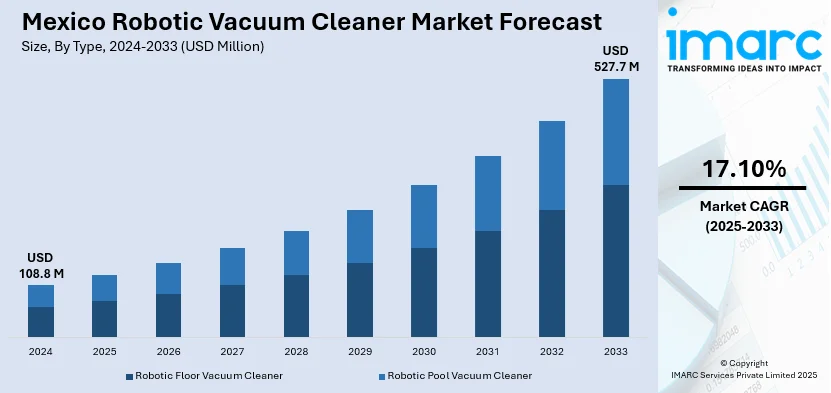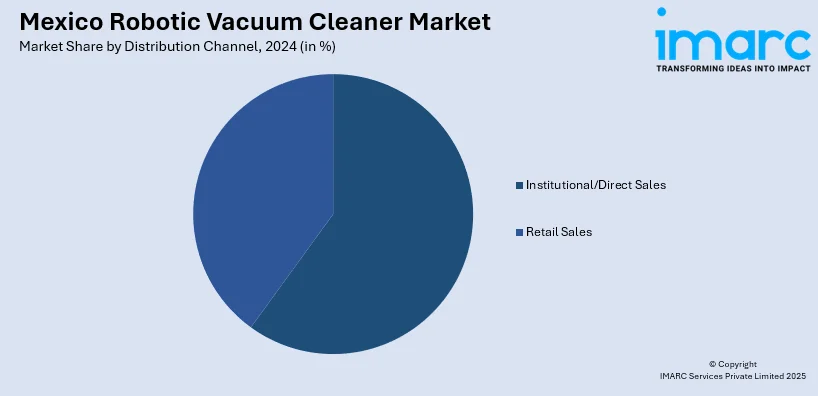
Mexico Robotic Vacuum Cleaner Market Size, Share, Trends and Forecast by Type, Type of Charging, Distribution Channel, Application, End-User, and Region, 2025-2033
Mexico Robotic Vacuum Cleaner Market Overview:
The Mexico robotic vacuum cleaner market size reached USD 108.8 Million in 2024. Looking forward, IMARC Group expects the market to reach USD 527.7 Million by 2033, exhibiting a growth rate (CAGR) of 17.10% during 2025-2033. The market is driven by the rising adoption of smart homes, busy lifestyles, and increasing demand for automated cleaning solutions. Technological advancements, including AI and advanced sensors, and affordability and convenience further boost consumer interest in robotic vacuum cleaners.
|
Report Attribute
|
Key Statistics
|
|---|---|
|
Base Year
|
2024 |
|
Forecast Years
|
2025-2033
|
|
Historical Years
|
2019-2024
|
| Market Size in 2024 | USD 108.8 Million |
| Market Forecast in 2033 | USD 527.7 Million |
| Market Growth Rate 2025-2033 | 17.10% |
Mexico Robotic Vacuum Cleaner Market Trends:
Adoption of Smart Home Technologies
The rise of smart home ecosystems in Mexico has significantly boosted the demand for robotic vacuum cleaners. Smartphone users, along with Google Home and Alexa assistant users, opt for devices that work with their voice assistant systems. Smart home automation systems benefit from robotic vacuum units that integrate Wi-Fi technology along with automated mapping functions. Through this integration, users gain a better cleaning experience because scheduling routines becomes simpler and more effective at saving time. As more households adopt smart technologies, robotic vacuums are viewed as essential appliances, which is fueling the Mexico robotic vacuum cleaner market share. The growth of IoT devices and expanding internet access across urban and semi-urban areas further support this trend, making smart, automated cleaning solutions highly desirable in modern Mexican homes.

Busy Urban Lifestyles and Time Constraints
Urbanization and fast-paced lifestyles in cities like Mexico City, Monterrey, and Guadalajara have led to a demand for time-saving household solutions. With both partners often working full-time, manual cleaning becomes a challenge. Robotic vacuum cleaners offer autonomous, scheduled cleaning without supervision, allowing homeowners to maintain hygiene effortlessly. These devices work quietly in the background, saving time for other priorities, which is further creating a positive impact on the Mexico robotic vacuum cleaner market outlook. The increased number of dual-income households and small living spaces has made robotic vacuums an ideal fit. Their ease of use, coupled with remote operation via apps, appeals to a generation that values convenience and multitasking in everyday routines.
Technological Advancements Enhancing Product Appeal
Technological innovation is a key factor behind the growing appeal of robotic vacuum cleaners in Mexico. Features such as AI-powered mapping, obstacle detection, dirt sensors, and self-emptying bins have improved product efficiency and appeal. High-end models now navigate more intelligently, remember floor layouts, and clean with precision. These enhancements reduce the need for human intervention, increasing their attractiveness. Additionally, battery life improvements, multi-surface cleaning ability, and noise reduction technologies contribute to consumer satisfaction and drive Mexico robotic vacuum cleaner market growth. As technology becomes more refined and reliable, even mid-range models now offer advanced features once reserved for premium segments, making innovation accessible to a broader market.
Mexico Robotic Vacuum Cleaner Market Segmentation:
IMARC Group provides an analysis of the key trends in each segment of the market, along with forecasts at the regional level for 2025-2033. Our report has categorized the market based on type, type of charging, distribution channel, application, and end-user.
Type Insights:
- Robotic Floor Vacuum Cleaner
- Robotic Pool Vacuum Cleaner
The report has provided a detailed breakup and analysis of the market based on the type. This includes robotic floor vacuum cleaner and robotic pool vacuum cleaner.
Type of Charging Insights:
- Manual Charging
- Automatic Charging
A detailed breakup and analysis of the market based on the type of charging have also been provided in the report. This includes manual charging and automatic charging.
Distribution Channel Insights:

- Institutional/Direct Sales
- Retail Sales
A detailed breakup and analysis of the market based on the distribution channel have also been provided in the report. This includes institutional/direct sales and retail sales.
Application Insights:
- Vacuum Cleaning Only
- Vacuum Cleaning and Mopping
A detailed breakup and analysis of the market based on the application have also been provided in the report. This includes vacuum cleaning only and vacuum cleaning and mopping.
End-User Insights:
- Residential
- Commercial
- Hospitality
- Offices
- Healthcare
- Retail
- Others
A detailed breakup and analysis of the market based on the end user have also been provided in the report. This includes residential and commercial (hospitality, offices, healthcare, retail, and others).
Regional Insights:
- Northern Mexico
- Central Mexico
- Southern Mexico
- Others
The report has also provided a comprehensive analysis of all the major regional markets, which include Northern Mexico, Central Mexico, Southern Mexico, and others.
Competitive Landscape:
The market research report has also provided a comprehensive analysis of the competitive landscape. Competitive analysis such as market structure, key player positioning, top winning strategies, competitive dashboard, and company evaluation quadrant has been covered in the report. Also, detailed profiles of all major companies have been provided.
Mexico Robotic Vacuum Cleaner Market Report Coverage:
| Report Features | Details |
|---|---|
| Base Year of the Analysis | 2024 |
| Historical Period | 2019-2024 |
| Forecast Period | 2025-2033 |
| Units | Million USD |
| Scope of the Report |
Exploration of Historical Trends and Market Outlook, Industry Catalysts and Challenges, Segment-Wise Historical and Future Market Assessment:
|
| Types Covered | Robotic Floor Vacuum Cleaner, Robotic Pool Vacuum Cleaner |
| Types of Charging Covered | Manual Charging, Automatic Charging |
| Distribution Channels Covered | Institutional/Direct Sales, Retail Sales |
| Applications Covered | Vacuum Cleaning Only, Vacuum Cleaning and Mopping |
| End-Users Covered |
|
| Regions Covered | Northern Mexico, Central Mexico, Southern Mexico, Others |
| Customization Scope | 10% Free Customization |
| Post-Sale Analyst Support | 10-12 Weeks |
| Delivery Format | PDF and Excel through Email (We can also provide the editable version of the report in PPT/Word format on special request) |
Key Questions Answered in This Report:
- How has the Mexico robotic vacuum cleaner market performed so far and how will it perform in the coming years?
- What is the breakup of the Mexico robotic vacuum cleaner market on the basis of type?
- What is the breakup of the Mexico robotic vacuum cleaner market on the basis of type of charging?
- What is the breakup of the Mexico robotic vacuum cleaner market on the basis of distribution channel?
- What is the breakup of the Mexico robotic vacuum cleaner market on the basis of application?
- What is the breakup of the Mexico robotic vacuum cleaner market on the basis of end-user?
- What is the breakup of the Mexico robotic vacuum cleaner market on the basis of region?
- What are the various stages in the value chain of the Mexico robotic vacuum cleaner market?
- What are the key driving factors and challenges in the Mexico robotic vacuum cleaner market?
- What is the structure of the Mexico robotic vacuum cleaner market and who are the key players?
- What is the degree of competition in the Mexico robotic vacuum cleaner market?
Key Benefits for Stakeholders:
- IMARC’s industry report offers a comprehensive quantitative analysis of various market segments, historical and current market trends, market forecasts, and dynamics of the Mexico robotic vacuum cleaner market from 2019-2033.
- The research report provides the latest information on the market drivers, challenges, and opportunities in the Mexico robotic vacuum cleaner market.
- Porter's five forces analysis assist stakeholders in assessing the impact of new entrants, competitive rivalry, supplier power, buyer power, and the threat of substitution. It helps stakeholders to analyze the level of competition within the Mexico robotic vacuum cleaner industry and its attractiveness.
- Competitive landscape allows stakeholders to understand their competitive environment and provides an insight into the current positions of key players in the market.
Need more help?
- Speak to our experienced analysts for insights on the current market scenarios.
- Include additional segments and countries to customize the report as per your requirement.
- Gain an unparalleled competitive advantage in your domain by understanding how to utilize the report and positively impacting your operations and revenue.
- For further assistance, please connect with our analysts.
 Request Customization
Request Customization
 Speak to an Analyst
Speak to an Analyst
 Request Brochure
Request Brochure
 Inquire Before Buying
Inquire Before Buying




.webp)




.webp)












